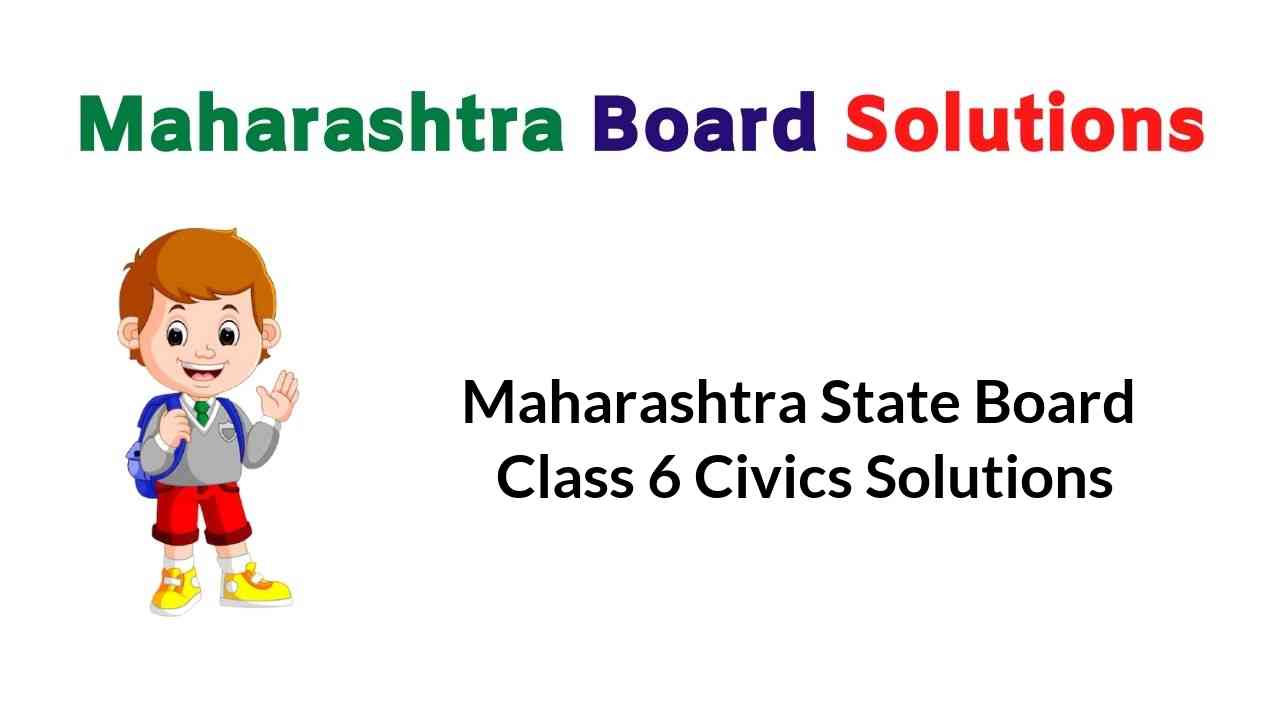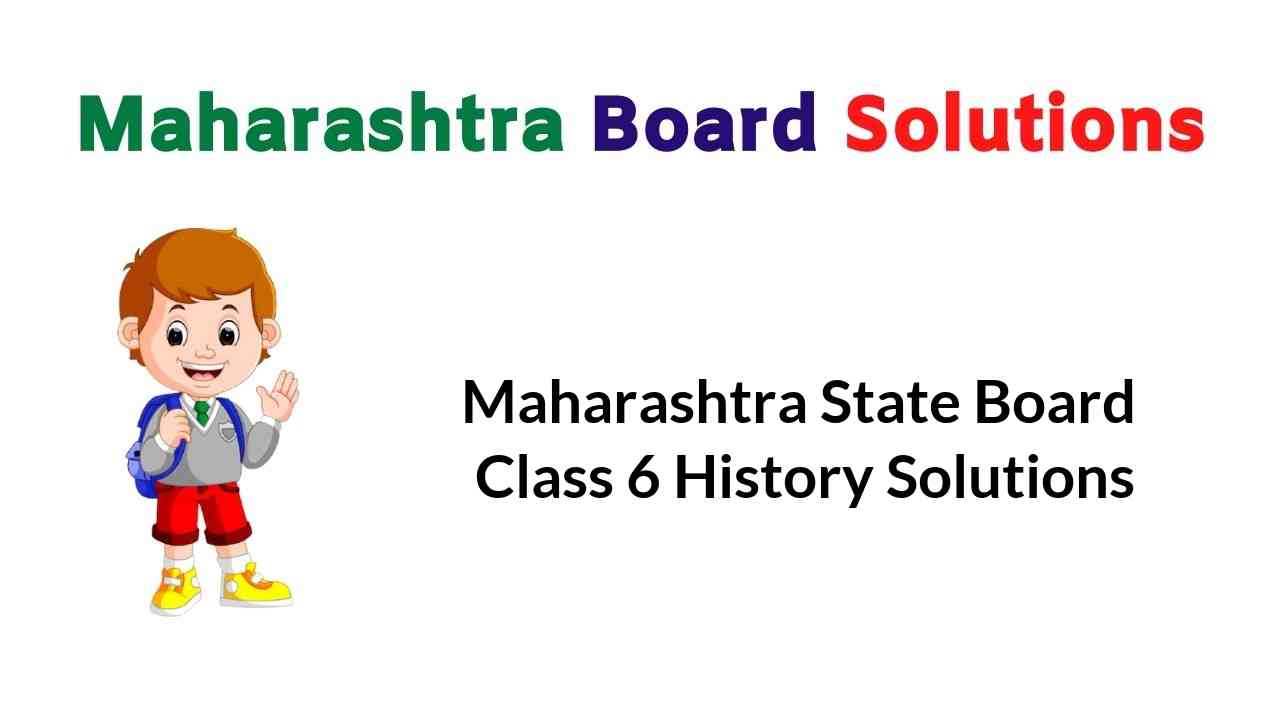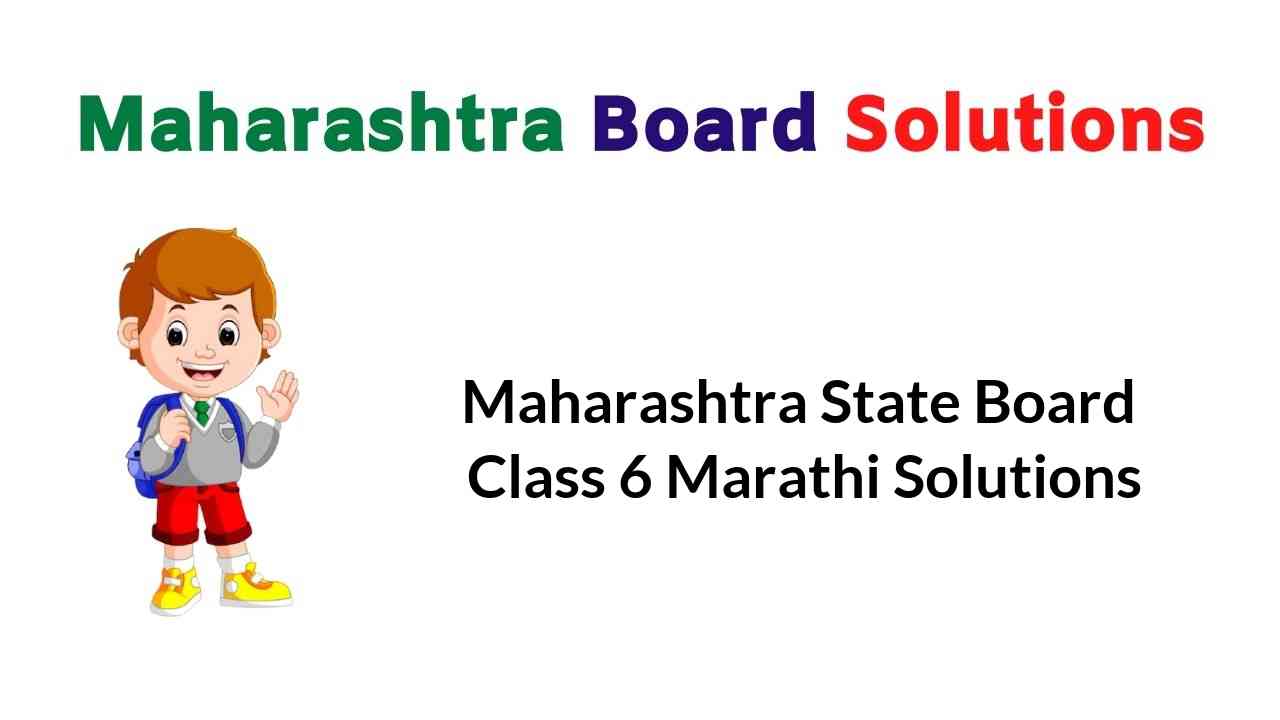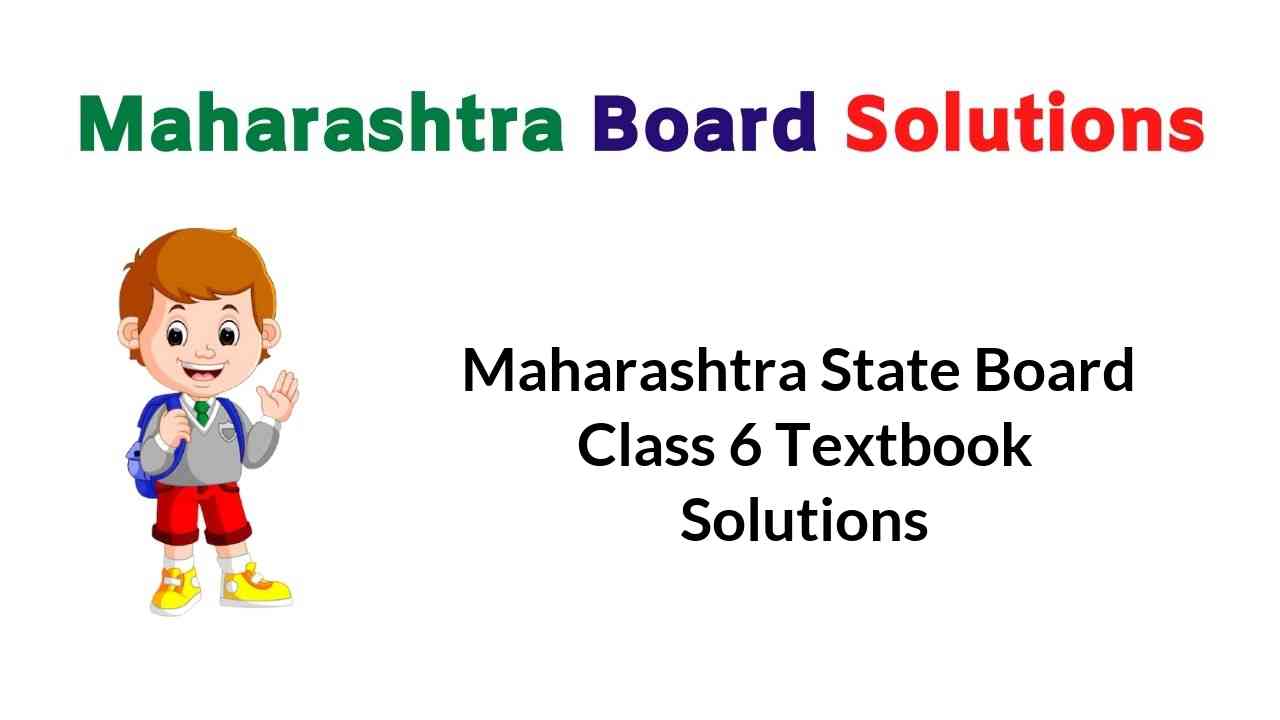 sachin
sachin
Maharashtra State Board Class 6 History Solutions
Maharashtra State Board 6th Std History Textbook Solutions
- Chapter 1 The Indian Subcontinent and History
- Chapter 2 Sources of History
- Chapter 3 The Harappan Civilization
- Chapter 4 The Vedic Civilization
- Chapter 5 Religious Trends in Ancient India
- Chapter 6 Janapadas and Mahajanapadas
- Chapter 7 India during the Maurya Period
- Chapter 8 States after the Maurya Empire
- Chapter 9 Ancient Kingdoms of the South
- Chapter 10 Ancient India: Cultural
- Chapter 11 Ancient India and the World
Maharashtra State Board Class 6 Marathi Sulabhbharati Solutions
Maharashtra State Board 6th Std Marathi Sulabhbharati Textbook Solutions
Marathi Sulabhbharati Class 6 Solutions
- Chapter 1 भारतमाता (गाणे)
- Chapter 2 माझा अनुभव
- Chapter 3 पाऊस आला! पाऊस आला! (कविता)
- Chapter 4 माहिती घेऊया
- Chapter 5 सुगरणीचे घरटे
- Chapter 6 हे खरे खरे व्हावे… (कविता)
- Chapter 7 उद्यानात भेटलेला विद्यार्थी
- Chapter 8 कुंदाचे साहस
- Chapter 9 घर (कविता)
- Chapter 10 बाबांचं पत्र
- Chapter 11 मिनूचा जलप्रवास
- Chapter 12 चंद्रावरची शाळा (कविता)
- Chapter 13 मोठी आई
- Chapter 14 अप्पाजींचे चातुर्य
- Chapter 15 होळी आली होळी (कविता)
- Chapter 16 मुक्या प्राण्यांची कैफियत
- Chapter 17 पाणपोई (कविता)
Maharashtra State Board Class 6 Textbook Solutions
Maharashtra State Board Class 6 English Balbharati Solutions
Maharashtra State Board 6th Std English Balbharati Textbook Solutions
English Balbharati Std 6 Answers Voyage 1
- Chapter 1.1 Don’t Give Up!
- Chapter 1.2 Who’s the Greatest?
- Chapter 1.3 Autobiography of a Great Indian Bustard
- Chapter 1.4 Children are Going to School …
- Chapter 1.5 A Kabaddi Match
- Chapter 1.6 The Peacock and the Crane
- Chapter 1.7 Param Vir Chakra: Our Heroes
English Digest Std 6 Maharashtra Board Voyage 2
- Chapter 2.1 The Clothesline
- Chapter 2.2 The Worth of a Fabric
- Chapter 2.3 A Wall Magazine for your Class!
- Chapter 2.4 Anak Krakatoa
- Chapter 2.5 The Silver House
- Chapter 2.6 Ad‘wise’ Customers
- Chapter 2.7 Yonamine and Bushi
Balbharti English Textbook Std 6 Solutions Voyage 3
- Chapter 3.1 It Can Be Done
- Chapter 3.2 Seven Sisters
- Chapter 3.3 Stone Soup
- Chapter 3.4 Sushruta (A Peep into the Past)
- Chapter 3.5 The Donkey
- Chapter 3.6 The Merchant of Venice
- Chapter 3.7 At the Science Fair
Std 6th English Workbook Answers Maharashtra Board Voyage 4
Maharashtra State Board Class 6 Textbook Solutions Answers Guide
Maharashtra State Board 6th Std Textbook Solutions Answers Guide
- Maharashtra State Board Class 6 Maths Solutions
- Maharashtra State Board Class 6 Science Solutions
- Maharashtra State Board Class 6 History Solutions
- Maharashtra State Board Class 6 Civics Solutions
- Maharashtra State Board Class 6 Geography Solutions
- Maharashtra State Board Class 6 English Solutions
- Maharashtra State Board Class 6 Hindi Solutions
- Maharashtra State Board Class 6 Marathi Solutions
Maharashtra State Board Class 5 Maths Solutions
Expert Teachers have created Maharashtra State Board Class 5 Maths Solutions. You can also Download the Maharashtra Board 5th Std Maths Digest Pdf Free Download to help you to revise the complete Syllabus and score more marks in your examinations.
Maharashtra State Board 5th Std Maths Textbook Solutions
Class 5 Maths Solution Maharashtra Board Part 1
Maharashtra Board Class 5 Maths Chapter 1 Roman Numerals
Maharashtra Board Class 5 Maths Chapter 2 Number Work
- Chapter 2 Number Work Problem Set 2
- Chapter 2 Number Work Problem Set 3
- Chapter 2 Number Work Problem Set 4
- Chapter 2 Number Work Problem Set 5
- Chapter 2 Number Work Problem Set 6
Maharashtra Board Class 5 Maths Chapter 3 Addition and Subtraction
- Chapter 3 Addition and Subtraction Problem Set 7
- Chapter 3 Addition and Subtraction Problem Set 8
- Chapter 3 Addition and Subtraction Problem Set 9
- Chapter 3 Addition and Subtraction Problem Set 10
- Chapter 3 Addition and Subtraction Problem Set 11
- Chapter 3 Addition and Subtraction Problem Set 12
- Chapter 3 Addition and Subtraction Problem Set 13
Maharashtra Board Class 5 Maths Chapter 4 Multiplication and Division
- Chapter 4 Multiplication and Division Problem Set 14
- Chapter 4 Multiplication and Division Problem Set 15
- Chapter 4 Multiplication and Division Problem Set 16
Maharashtra Board Class 5 Maths Chapter 5 Fractions
- Chapter 5 Fractions Problem Set 17
- Chapter 5 Fractions Problem Set 18
- Chapter 5 Fractions Problem Set 19
- Chapter 5 Fractions Problem Set 20
- Chapter 5 Fractions Problem Set 21
- Chapter 5 Fractions Problem Set 22
- Chapter 5 Fractions Problem Set 23
Maharashtra Board Class 5 Maths Chapter 6 Angles
- Chapter 6 Angles Problem Set 24
- Chapter 6 Angles Problem Set 25
- Chapter 6 Angles Problem Set 26
- Chapter 6 Angles Problem Set 27
Maharashtra Board Class 5 Maths Chapter 7 Circles
- Chapter 7 Circles Problem Set 28
- Chapter 7 Circles Problem Set 29
- Chapter 7 Circles Problem Set 30
- Chapter 7 Circles Problem Set 31
5th Std Maths Digest Pdf Maharashtra Board Part 2
Maharashtra Board Class 5 Maths Chapter 8 Multiples and Factors
- Chapter 8 Multiples and Factors Problem Set 32
- Chapter 8 Multiples and Factors Problem Set 33
- Chapter 8 Multiples and Factors Problem Set 34
- Chapter 8 Multiples and Factors Problem Set 35
Maharashtra Board Class 5 Maths Chapter 9 Decimal Fractions
- Chapter 9 Decimal Fractions Problem Set 36
- Chapter 9 Decimal Fractions Problem Set 37
- Chapter 9 Decimal Fractions Problem Set 38
- Chapter 9 Decimal Fractions Problem Set 39
- Chapter 9 Decimal Fractions Problem Set 40
- Chapter 9 Decimal Fractions Problem Set 41
- Chapter 9 Decimal Fractions Problem Set 42
Maharashtra Board Class 5 Maths Chapter 10 Measuring Time
- Chapter 10 Measuring Time Problem Set 43
- Chapter 10 Measuring Time Problem Set 44
- Chapter 10 Measuring Time Problem Set 45
Maharashtra Board Class 5 Maths Chapter 11 Problems on Measurement
Maharashtra Board Class 5 Maths Chapter 12 Perimeter and Area
- Chapter 12 Perimeter and Area Problem Set 48
- Chapter 12 Perimeter and Area Problem Set 49
- Chapter 12 Perimeter and Area Problem Set 50
Maharashtra Board Class 5 Maths Chapter 13 Three Dimensional Objects and Nets
Maharashtra Board Class 5 Maths Chapter 14 Pictographs
Maharashtra Board Class 5 Maths Chapter 15 Patterns
Maharashtra Board Class 5 Maths Chapter 16 Preparation for Algebra
Maharashtra State Board Class 5 Environmental Studies Solutions EVS Part 1 & 2
Maharashtra State Board Environmental Studies EVS Part 1 & Part 2 Standard 5th Solutions Digest Answers Pdf Download, 5th Std EVS 1, 2 Digest Pdf, Environmental Studies Part 1, 2 Standard 5th Question Answer.
Maharashtra State Board 5th Std EVS Textbook Solutions
Environmental Studies Part 1 Standard 5th Digest
Maharashtra State Board Environmental Studies EVS Part 1 Standard 5th Digest Solutions Question Answer Pdf.
- Chapter 1 Our Earth and Our Solar System
- Chapter 2 Motions of the Earth
- Chapter 3 The Earth and its Living World
- Chapter 4 Environmental Balance
- Chapter 5 Family Values
- Chapter 6 Rules Are for Everyone
- Chapter 7 Let us Solve Our own Problems
- Chapter 8 Public Facilities and My School
- Chapter 9 Maps – Our Companions
- Chapter 10 Getting to Know India
- Chapter 11 Our Home and Environment
- Chapter 12 Food for All
- Chapter 13 Methods of Preserving Food
- Chapter 14 Transport
- Chapter 15 Communication and Mass Media
- Chapter 16 Water
- Chapter 17 Clothes – Our Necessity
- Chapter 18 The Environment and Us
- Chapter 19 Constituents of Food
- Chapter 20 Our Emotional World
- Chapter 21 Busy at Work – Our Internal Organs
- Chapter 22 Growth and Personality Development
- Chapter 23 Infectious Diseases and how to Prevent them
- Chapter 24 Substances, Objects and Energy
- Chapter 25 Community Health and Hygiene
Environmental Studies Part 2 Standard 5th Digest
Maharashtra State Board Environmental Studies EVS Part 2 Standard 5th Digest Solutions Question Answer Pdf.
- Chapter 1 What is History?
- Chapter 2 History and the Concept of ‘Time’
- Chapter 3 Life on Earth
- Chapter 4 Evolution
- Chapter 5 Evolution of Mankind
- Chapter 6 Stone Age: Stone Tools
- Chapter 7 From Shelters to Village-settlements
- Chapter 8 Beginning of Settled Life
- Chapter 9 Settled Life and Urban Civilization
- Chapter 10 Historic Period
Maharashtra State Board Class 5 Textbook Solutions
Maharashtra State Board Class 5 English Balbharati Solutions
Maharashtra State Board 5th Std English Textbook Digest Answers Pdf Download, English Balbharati Workbook Std 5 Answers, 5th Standard English Question Answer.
Maharashtra State Board 5th Std English Balbharati Textbook Solutions
Balbharti English Textbook Std 5 Pdf Free Download Unit 1
- Chapter 1 What a Bird Thought
- Chapter 2 Daydreams
- Chapter 3 Be a Good Listener
- Chapter 4 Strawberries
- Chapter 5 The Twelve Months
- Chapter 6 Announcements
- Chapter 7 Major Dhyan Chand
- Chapter 8 Peer Profile
English Balbharati Workbook Std 5 Answers Unit 2
- Chapter 9 The Triantiwontigongolope
- Chapter 10 Three Sacks of Rice
- Chapter 11 Be a Good Speaker
- Chapter 12 Count your Garden
- Chapter 13 The Adventures of Gulliver
- Chapter 14 A Lesson for All
- Chapter 15 Bird Bath
- Chapter 16 Write your own Story
English Balbharati Std 5 Textbook Digest Unit 3
- Chapter 17 On the Water
- Chapter 18 Weeds in the Garden
- Chapter 19 Be a Good Host and Guest
- Chapter 20 Only One Mother
- Chapter 21 The Journey to the Great Oz
- Chapter 22 A Book Review
- Chapter 23 Write your own Poem
- Chapter 24 Senses Alert
English Balbharati Std 5 Answers Unit 4
- Chapter 25 The Man in the Moon
- Chapter 26 Water in the Well
- Chapter 27 The Legend of Marathon
- Chapter 28 All about Money
- Chapter 29 A Lark
- Chapter 30 Be a Netizen
- Chapter 31 Give your Mind a Workout!
- Chapter 32 Helen Keller
- Chapter 33 Rangoli
Maharashtra State Board Class 5 Textbook Solutions
Maharashtra State Board Class 5 Hindi Sulabhbharati Solutions
Maharashtra State Board 5th Standard Hindi Sulabhbharati Digest Pdf Download, 5th Standard Hindi Textbook Questions and Answers.
Maharashtra State Board 5th Std Hindi Sulabhbharati Textbook Solutions
5th Std Hindi Digest Pdf Download पहली इकाई
- Chapter 1 नंदनवन
- Chapter 2 बूँदें
- Chapter 3 योग्य चुनाव
- Chapter 4 कश्मीरा
- Chapter 5 पहचान हमारी – भाग (१)
- Chapter 6 पेटूराम
- Chapter 7 बधाई कार्ड
- Chapter 8 करो और जानो
- Chapter 9 नीम
- Chapter 10 गड़ा धन
- Chapter 11 मित्रता
- Chapter 12 बचत
- Chapter 13 पहचान हमारी – भाग (२)
- Chapter 14 मैं सड़क हूँ
- Chapter 15 व्यायाम
- Chapter 16 बोलो और जानो
- स्वयं सध्ययन
- पुनरावर्तन १
- पुनरावर्तन २
Hindi Sulabhbharati 5th Standard Pdf दूसरी इकाई
- Chapter 1 गाँव और शहर
- Chapter 2 जीवन
- Chapter 3 भाई-भाई का प्रेम
- Chapter 4 बालिका दिवस
- Chapter 5 रोबोट
- Chapter 6 जुड़े हम
- Chapter 7 (अ) बोध, (ब) समान – विरुद्ध
- Chapter 8 बीज
- Chapter 9 मुझे पहचानो
- Chapter 10 मुझे जानो
- Chapter 11 वीरों को प्रणाम
- Chapter 12 सपूत
- Chapter 13 राष्ट्रीय त्योहार
- Chapter 14 (अ) हम अलग – रूप एक, (ब) धुक-धुक गाड़ी
- Chapter 15 ज्ञानी
- Chapter 16 बचाव
- Chapter 17 निरिक्षण
- Chapter 18 चलों-चलें
- स्वयं सध्ययन
- पुनरावर्तन ३
- पुनरावर्तन ४
Maharashtra State Board Class 5 Textbook Solutions
Maharashtra State Board Class 5 Marathi Sulabhbharati Solutions
Maharashtra State Board 5th Standard Marathi Sulabhbharati Digest Pdf Download, 5th Standard Marathi Textbook Question Answer, Textbook Workbook Answers.
Maharashtra State Board 5th Std Marathi Sulabhbharati Textbook Solutions
5th Standard Marathi Digest Pdf Download
- Chapter 1 नाच रे मोरा
- Chapter 2 हत्तीचे चातुर्य
- Chapter 3 खेळूया शब्दांशी
- Chapter 4 हि पिसे कोणाची ?
- Chapter 5 डराव डराव
- Chapter 6 ऐकुया खेळूया
- Chapter 7 खेळत खेळत वाचुया!
- Chapter 8 कोणापासून काय घ्यावे?
- Chapter 9 सिंह आणि बेडूक
- Chapter 10 बैलपोळा
- Chapter 11 इंधनबचत
- Chapter 12 बोलावे कसे?
- Chapter 13 अनुभव-१
- Chapter 14 चित्रसंदेश
- Chapter 15 नदीचे गाणे
- Chapter 16 मी नदी बोलते
- Chapter 17 आमची सहल
- Chapter 18 पैशांचे व्यवहार
- Chapter 19 अनुभव-२
- Chapter 20 गमतीदार पत्र
- Chapter 21 छोटेसे बहीणभाऊ
- Chapter 22 वाचूया लिहूया
- Chapter 23 प्रामाणिक इस्त्रीवाला
- Chapter 24 ऐका पहा करा
- Chapter 25 मालतीची चतुराई
- Chapter 26 पतंग
- Chapter 27 महर्षी विठ्ठल रामजी शिंदे
- Chapter 28 फुलपाखरू आणि मधमाशी
Maharashtra State Board Class 5 Textbook Solutions




